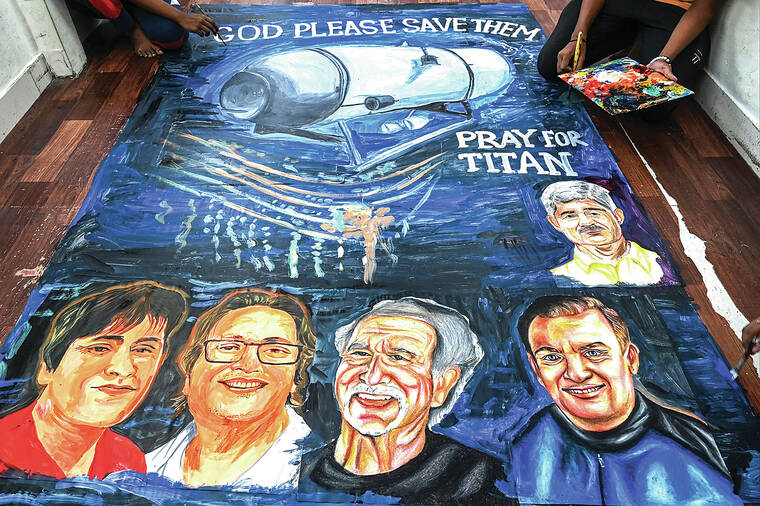Deep in the Atlantic, a ‘catastrophic implosion’ and five lives lost
A vast multinational search for five people who had descended to view the wreckage of the sunken RMS Titanic ended on Thursday after pieces of the privately owned submersible vessel that had carried them were found on the ocean floor, evidence of a “catastrophic implosion” with no survivors, according to the U.S. Coast Guard.
The dramatic search effort, in a remote area of the North Atlantic 900 miles off Cape Cod, Massachusetts, had mesmerized people worldwide for days after the 22-foot watercraft, called Titan, lost contact with its parent ship less than two hours into its voyage on Sunday. The grim discovery, by a remotely operated vehicle scouring the sea bottom, also trained attention on high-risk, high-cost adventure tourism, raising questions about the safety protocols followed by companies that run such expeditions.
ADVERTISING
“Our thoughts are with the families and making sure they have an understanding, as best as we can provide, of what happened,” Rear Adm. John Mauger, commander of the First Coast Guard District, said at a news conference in Boston. “It is a complex case to work through, but I’m confident those questions will begin to get answered.”
Stockton Rush, 61, the CEO of OceanGate Expeditions, the company that owned Titan, was piloting the submersible and among those presumed dead. Others on board were Hamish Harding, 58, a British explorer; Paul-Henri Nargeolet, 77, a French maritime expert who had made more than 35 dives to the Titanic; Shahzada Dawood, 48, a British businessman; and his 19-year-old son, Suleman Dawood, a university student.
The quest for the missing vessel was seen at the start as a race against time, as rescuers who hoped the Titan might still be intact hurried to reach the area where it had descended before its supply of oxygen ran out. Hopes surged Wednesday, after banging noises were detected underwater by maritime surveillance planes; U.S. Navy experts analyzed the sounds for signs that they might be attempts by the Titan’s passengers to signal their location.
But on Thursday afternoon, four days after the vessel went missing, those hopes were extinguished by evidence discovered more than two miles beneath the ocean surface: the tail cone of the Titan adrift on the sea floor, one-third of a mile from the bow of the Titanic, along with the two broken ends of its pressure hull. The debris, Mauger said, was “consistent with the catastrophic loss of its pressure chamber.”
On Thursday evening, a U.S. Navy official said that underwater sensors had registered readings “consistent with an explosion or implosion” shortly after the loss of contact. That information was sent to the incident commander to help narrow down the search area, the official said.
Without conclusive evidence of a catastrophic failure, it would have been “irresponsible” to assume the five people were dead, the Navy official said, so the mission was treated as an ongoing search and rescue even as the outcome appeared grim.
The Wall Street Journal was the first to report the Navy’s possible detection of the implosion.
Asked about the prospect of recovering the bodies of the victims, Mauger said he did not have an answer. “This is an incredibly unforgiving environment down there on the sea floor,” he said.
The search for the Titan drew an international response, as French, British and Canadian ships struck out for the final resting place of the Titanic, ferrying high-tech search-and-rescue equipment. There was a robot capable of searching 13,000 feet below the ocean’s surface, and a hyperbaric recompression chamber used to treat diving-related illnesses. But the effort was slowed by the sheer distance they had to travel to reach the site, a journey of several days for some.
There is no indication that the vessel imploded as a result of a collision with the Titanic wreckage; the debris from the Titan was found in a nearby area where the sea bottom is smooth, said Carl Hartsfield, an underwater vehicle designer at the Woods Hole Oceanographic Institution in Massachusetts who assisted the Coast Guard in the search.
Nine vessels remained in the area as the search for remnants of the Titan, and mapping of the debris field, continued on Thursday afternoon, but Mauger said they would begin to disperse in the next 24 hours.
“These men were true explorers who shared a distinct spirit of adventure, and a deep passion for exploring and protecting the world’s oceans,” OceanGate Expeditions said in a statement. “Our hearts are with these five souls and every member of their families during this tragic time.”
The Titan’s final dive almost did not happen, as weather conditions failed to cooperate. When a window suddenly opened, Harding, a veteran explorer, saw it as a lucky break. “Due to the worst winter in Newfoundland in 40 years,” he wrote in a social media post last Saturday, “this mission is likely to be the first and only manned mission to the Titanic in 2023.”
His last dive was far from his deepest. In 2021, Harding made a record-setting trip to the deepest part of the Mariana Trench, in the western Pacific Ocean. A four hour, 15-minute drop of 36,000 feet, the trek took him nearly three times deeper than the site of the Titanic. According to a media report at the time, only 18 people had ever journeyed to the area, known as the Challenger Deep. By comparison, 24 astronauts have orbited or landed on the moon.
Harding knew the risks. “If something goes wrong, you are not coming back,” he said in an interview after the dive in 2021.
© 2023 The New York Times Company





